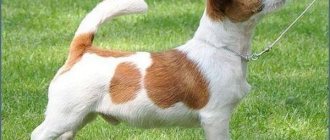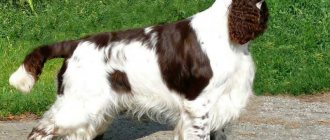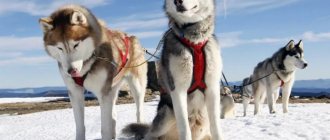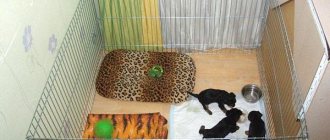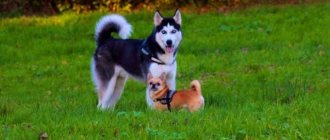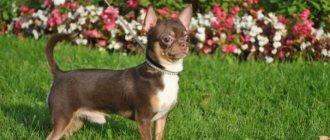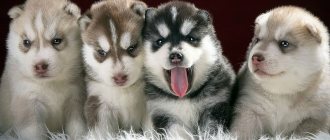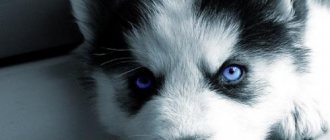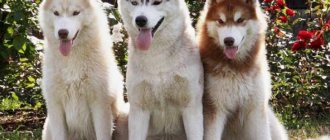If you get a Husky puppy, you may be surprised at how quickly they grow. When I got my husky, I started wondering if he would ever stop growing. Let's find out how tall huskies are and when they stop growing.
So, at what age do huskies stop growing? Huskies usually stop growing in height after 18 months . However, they will continue to get bigger, stronger and heavier until they are about 3 years old . During this time they will undergo many physical and mental transformations.
Huskies will grow and mature in a relatively short period of time and reach adulthood at around 2 years of age. The first couple of years are the most important when it comes to your Husky's health and personality.
Height and weight
The weight of males should be from 20.5 to 28 kg, and that of females from 15.5 to 23 kg.
Height at the withers in adult representatives of the breed should be from 53.5 to 60 cm in males and from 50.5 to 56 cm in females.
The neck circumference of a husky is from 43 to 51 cm.
Considering that the body format of these dogs is only slightly stretched, the length of their body should exceed the height at the withers by no more than 1-3 cm.
Expert opinion
Tolkachev Andrey Mikhailovich
veterinarian
“The Husky's weight must be in the correct proportion to weight and within the standard range. Not all owners of these dogs feed their pets correctly and at the same time do not provide them with the necessary exercise. As a result, the husky quickly gains excess weight, which negatively affects not only his appearance, but also his health. "Obese dogs are more susceptible to diseases such as diabetes or heart disease, and for female dogs, being overweight can cause complications during pregnancy and childbirth."
The importance of monitoring a dog's development
If the pet was purchased from a good breeder, then it is not necessary to count when she becomes an adult. For these purposes, you can simply meet the dog’s parents. This procedure is the norm among professional breeders and is carried out before the puppy is handed over to its new owners.
In the case where a dog was picked up on the street or adopted from a shelter, it is quite difficult to guess. It is impossible to say to what parameters it will eventually grow. Mongrels are extremely unpredictable in this regard.
To understand how many months dogs grow, you need to regularly weigh them and measure their dimensions. Until two months of age, it is recommended to perform the procedure once every 5-6 days. Up to six months, the frequency of measurements should be increased to 10 days. Subsequently, you can record their dimensions once a month. Worth measuring:
- the height of the animal at the withers;
- paw circumference;
- paw height to elbow;
- chest girth.
Note! It is imperative to measure your pet in order to notice deviations in its development in time. Parameters can be measured using a tape measure, a measuring tape, and the pet can be weighed using household or food scales, depending on the size of the animal.
Weighing the dog
Puppy weight and sizes from 1 to 12 months
The table shows the average size of a husky puppy by month.
| Husky puppy age | Weight | Height |
| 1 month | Weight - about 3 kg | Height - not measured |
| 2 months | Weight - 5-6 kg kg | Height - 31 cm |
| 3 months | Weight - 11.5 kg | Height - 43 cm |
| 4 months | Weight - 12-15 kg | Height - 47-48 cm |
| 5 months | Weight - 13-18 kg | Height - 48-52 cm |
| 6 months | Weight - 15.5-20.5 kg | Height - 49-54 cm |
| 7 months | Weight - 16.6-24 kg | Height - 51-57 cm |
| 8 months | Weight - 17.5-25 kg | Height - 53-58 cm |
| 9 months | Weight - 18.5-26.5 kg | Height - 53-58 cm |
| 10 months | Weight - 20-27 kg | Height - 53-58 cm |
| 11 months | Weight - 21-27.5 kg | Height - 54-59 cm |
| 1 year | Weight - 23-28 kg | Height - 54-59 cm |
How to measure correctly?
Height should be measured by placing the pet on a flat, hard surface . It is very important that the husky stands still during measurements.
To do this, if the pet has already been trained for this, you can put it in a show rack or attract its attention by showing it a treat or toy.
Moreover, if the second method is chosen, then it is better to resort to the help of assistants from among relatives, since it will be difficult to independently hold the dog’s attention and measure it at the same time.
Next, you need to take a measuring tape or a special device for measuring a dog’s height, made from a long ruler and a limiter that can be moved along the entire length.
The centimeter must be applied with the edge with the smallest divisions to the animal’s withers, then pull the edge of the tape to the floor and mark the desired value below.
A height meter made from a ruler should be placed with one edge on the floor, and then the stop should be raised to the level of the pet’s withers.
It is more convenient to measure the growth of small puppies up to about three months of age on a table, but you need to make sure that the baby does not fall off it or jump onto the floor.
Brief history of the breed
The breed's brief history begins in Siberia, about 4,000 years ago. The Siberian Husky is an aboriginal breed of “pure” origin.
Siberia is considered one of the coldest regions, but at the time the breed was bred, the climate was a little milder. In the area where the dogs lived, there were many reindeer, which were considered the main prey of hunters.
Dramatic changes in climatic conditions forced deer to migrate, and hunters were forced to adapt to a nomadic lifestyle. It was during this period that most of the huskies were retrained as sled dogs.
It is interesting that in times of struggle for life, people treated assistance dogs with great respect. For example, only children, sick adults and old people had the right to ride in sleighs. All adults who could walk wandered “on their own two feet.” Quite often, adult men and even women replaced the dogs and pulled the sleigh with the load while the four-legged dogs walked alongside.
This is interesting! Residents of Siberia held huskies in deep reverence for moral and religious reasons. According to legend, the gates to heaven were guarded by two huskies, so people who treated dogs poorly during life could not find eternal peace after death.
In the process of developing the breed, another basic skill was instilled in it - the ability to live among a large number of animals of a different species. Today, this skill is called high sociality. The skill was introduced when people began to domesticate deer, that is, the latter acquired the status of pets and not prey. At that time, there were at least three varieties of huskies: sledding, hunting and herding.
This is interesting! The Siberian Husky is considered the record holder for the fastest transport of light loads over long distances.
To what age do they grow?
Until six months of age, all puppies of this breed grow at approximately the same rate, but later their development acquires some differences, depending on the gender of the pet.
Bitches grow actively until about 8 months, after which the final growth spurt continues for up to a year . Weight and muscle mass continue to increase until approximately 2 years of age - until the dog is fully formed.
In males, the active growth phase is somewhat longer - up to approximately 9 months. Then, up to 1.5 years, the dog continues to develop, and is finally formed only by 2-3 years.
The bitch's growth may slow down with the onset of her first heat , but later it most often recovers and continues for several more months .
What affects the parameters?
The height and weight of a husky puppy can depend on several reasons.:
- Heredity . It is she who determines to what age and how intensively the puppy will grow. In females, in addition, the age at which the first estrus occurs depends on the characteristics of the genotype - the period when active growth slows down or even stops, as happens in representatives of some lines.
- Quality of cultivation . How well the babies will grow and what size they will reach by the time of sale depends on what conditions were provided in the breeder’s home for the pregnant bitch and puppies.
- Feeding in a new home . For normal growth and weight gain, what and how correctly the new owner feeds his pet is of great importance. If the owner provides the baby with all the products he needs through natural feeding or feeds the puppy with high-quality complete food, he will grow well and gain weight. However, it should be taken into account that puppies raised on natural food initially grow at a faster rate than those fed with ready-made food.
- Conditions of detention. Puppies kept outdoors usually gain growth quite quickly, but due to the fact that they are constantly on the move, they can weigh less than dogs living in an apartment and not receiving intense physical exercise.
- Past illnesses . Those puppies who suffered from serious infectious diseases at an early age grow and gain weight worse than their peers.
- Physical activity . With increased physical activity, huskies gain less weight, but grow well in height. If growing puppies lead an inactive lifestyle, they may lag behind their peers in height, but at the same time have significantly more weight.
The rate of growth and weight gain may not depend on any of the above reasons and may be associated solely with the individual developmental characteristics of a particular puppy.
Relationships with children
If there are kids in your family, then you don’t have to be afraid to get a husky. This breed is not aggressive and loves children of any age. The Eskimos even used representatives of this breed to warm newborn children. The fact is that among northern peoples the birth of a baby is considered not just joy, but a real miracle. After all, bearing, giving birth and keeping a child in special climatic conditions is very difficult. Therefore, immediately after giving birth, a pack of huskies was driven into a dwelling, where they warmed the baby for several months. If he was weak and not in good health, then several animals were sometimes left near him for a longer period of time.
It is noteworthy that even husky crosses with other breeds are distinguished by their love for children. Although such dogs have no exhibition value.
What to do if your weight is below normal
It should be noted that the tables usually show the average height and weight characteristic of a particular age, and therefore there is no need to consider these parameters mandatory.
Therefore, if the puppy’s weight lags behind them by no more than 10%, then such an imaginary underweight should be considered a variant of the norm.
CAREFULLY!
In the same case, if there is a significant lag in weight, you need to try to quickly find out the reason for this.
Perhaps nothing terrible is happening and the lack of weight is due to the individual characteristics of the puppy. The baby simply grows very quickly in height and at the same time is distinguished by great mobility, which is why there is a lack of body weight.
In this case, you do not need to do anything, you just need to wait until the end of the active growth phase, after which the young dog will quickly gain the required weight.
The same applies to cases where underweight is due to heredity, when dogs from different lines grow faster or slower.
If underweight is associated with an incorrectly selected diet, then it is recommended to increase the amount of proteins and fats during natural feeding, and if the pet receives ready-made food, then try to choose a different brand for it with a higher nutritional value.
Vitamin and mineral supplements can also help, which, due to the beneficial microelements they contain, have an overall beneficial effect on the animal’s body..
In any case, before giving your husky any supplements, you should consult your veterinarian.
If we are talking not about puppies, but about adult dogs, then the problem of underweight can be solved by increasing the duration of walks and increased physical activity, including working in a harness.
Features of caring for a husky
The history of origin of the Siberian Husky dates back to ancient times, from sled dogs.
The ability to get by on meager rations and travel kilometers in a harness are the main qualities that have been consolidated and improved in the husky breed for centuries.
In addition, these animals, the closest companions of people, spent the night in yurts during particularly severe blizzards and frosts, warming their owners and their babies with their warmth.
Therefore, a mighty dog is attached to a person with the most tender feelings, is faithful, affectionate and reverent towards children.

